by Alina Epîngeac
What does “renowned” mean anymore? Nowadays, when history seems to be as relative as anything, when aesthetics and culture are exchanged with an emphasis on social and political matters, what are the performance qualities that can serve as a model? In Romanian theatre, there are few directors who keep their legendary aura. Because of their successes in the 1990s, names such as Silviu Purcărete or Andrei Şerban are still recognized in the European theatre community. And for a good reason. Their acclaimed stagings of ancient Greek tragedies, for example, continue to constitute the landmarks of creativity, relevance, and emotion.
Nevertheless, Romanian theatre does not end with their “reign.” The young directors who have followed them have brought their own vision and personality to the theatre of the 2000s. Arguably the most influential figure in the Romanian theatre landscape today is Radu Afrim. A director with a most vivid inner universe, who gracefully weaves together metaphors, humor, drama, social impact, and a very consistent aesthetic, into a poetry of theatrical images that speaks volumes in the matter of thoughts and feelings. Initially considered an “enfant terrible,” he still remains one of the rebels who challenge tradition and subverts the “classic” manner of staging grand authors. His work kept going deeper and deeper into an authentic concern for polishing the surface of form until reaching its symbolic core of expression.
Three of his last performances produced during COVID-19-related lockdowns in the autumn of 2020 and 2021 seem to be part of a trilogy of fear, love, and despair. The dense atmosphere agglutinated around these powerful emotions that have bound us all together these past few years traverses three very different stories and binds them in a node of theatrical beauty.
Essay on the anatomy of love: “The heart and other meat products”
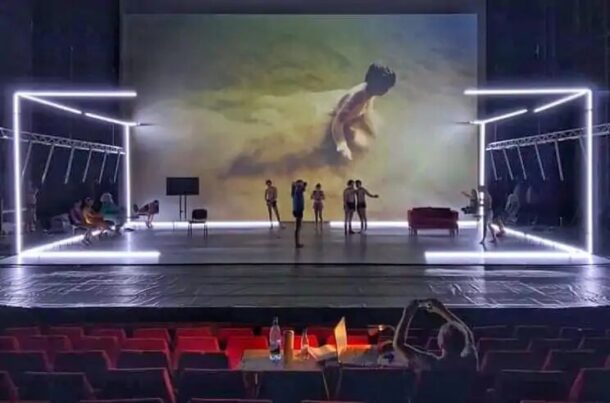
Heart and Other Meat Products, written by Dan Coman and directed by Radu Afrim. Photo: Marin Sorescu National Theatre.
Feelings can also go numb. Love most of all. Just as you feel your leg stung by thousands of needles and quickly press your heel down into the ground, trying to make the pain bearable, the same happens with the most sensitive feelings: the tenderness, the candor, the fondness, the sensuality—the colorful shards that make up that love that poets fit in the meter of verses. These senses can also collapse under the pain of stings, just like numb limbs do. And the heart, not unlike other meat “products,” needs to press its heel into the floor, to make the pain bearable.
Heart and Other Meat Products, written by Dan Coman and directed by Radu Afrim at the Marin Sorescu National Theatre in Craiova, is a show like a love story: with candid enthusiasms, with games scorned by the intelligence of mischievous children, with cynical humor, with bitter-sweet self-immolation, with betrayals, with silences that shout their helplessness, with crises, with depressions, with anguish, with memories preserved in perfect images, with serious accidents that mutilate souls involuntarily and a gentle happiness that puts a band-aid on the “meat products” of our souls. The elegant-percussive aesthetics of Coman’s verse meets on stage with Afrim’s playful fantasy, and their date is materialized in a very well-weighted cohabitation. The harsh and abrupt lyricism, the metaphors about the labrador butterfly and the hearts and the coffee and the snow and the childish drawings and the rhythm given by the words that clash bluntly in the verse find their complementary half in the very terre-à-terre humor and the plastic, vibrant, beautifully simple images and the cynically humorous counterpoints.
A few sad couples tell their stories with the vibe of an implacable destiny before which they can do nothing but exist—as it has been written. The characters’ apathetic distancing from the dramas that have hacked their hearts (and other meat products) works like a magnifying glass based on episodes of torment seen by a comic eye suffering from hyperopia. Adulterous lovers consume their story with detachment, lonely wives sin without any pleasure in return, high-school girls taste kisses with the scent of mint candy, high-school boys have fun by bullying and abusing just because they do not know any better, a worker mourns his love that has been used as a masquerade among asparagus seedlings, a blonde girl buys strollers and strollers of supplies during lock-down and, among all, over all, a giant butterfly makes pirouettes, listens to them sitting in an armchair, plunges, rolls, jumps, runs, struggles, lives its life as an ephemeral giant, as a witness of all the pains of hearts wrapped in plastic-covered casseroles.
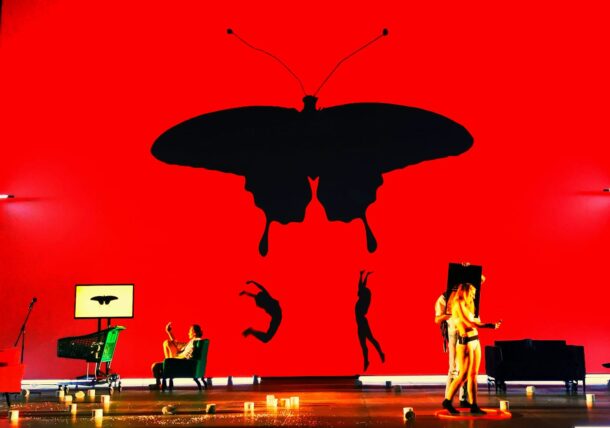
Heart and Other Meat Products, written by Dan Coman and directed by Radu Afrim. Photo: Marin Sorescu National Theatre.
When a 37-year-old teacher, uncomfortable with her appearance, massive, and resigned from any chance of happiness, tells the story of her long-term high school sexual abuse you immediately connect to this empathic and fragile character. Her broken smile and her simple narration keep the perfect balance between tears and dignity. Then a middle-aged woman poetically expresses her urge to be held, to cuddle. The emotional scars she is left with after a first marriage make her vulnerable to any intimate act. She interacts with her lover tenderly, in a very fluid choreography, and expresses this urge for tenderness and also violence towards any intent of sexual intercourse. Men are also prone to heartbreak in this poetical puzzle of fragility. A poor, simple worker who went to Germany on his own to find a job, fell in love with a superficial girl who only saw him as a sex object. Behind the funny appearance and the mild tone, his story of abandonment is as valid as any other person who thought they met a perfect match only to be left all alone, feeling used and cheated in their feelings.
In a large and empty space, like the one the most beautiful love leaves behind in the heart of the most sensitive being, Irina Moscu’s scenography configures paths, delimits plots of existence and composes a world out of several elements of décor, like a catwalk above obsolescence. Many costumes involve personification by a single defining feature that enhances the multiple characters enacted by each performer. The unifying intention of the staging imprinted in the interpretation as a paradox between oniric lyricism and naturalistic everyday appearance is the glue that makes the interspersed scenes work. The sonic universe alternates between low vibrations and prolonged notes with choruses of hits from discos long-gone, remixed and attuned to the same intelligent humor. Video projections become an alter ego of the scenes and act as a very successful aesthetic and connotative background to the poetic meaning. The actors understood well this engaged-distanced way of playing and each one assumes their share of coloring the contours of this sensitive kinetic painting.
Heart and Other Meat Products directed by Afrim is a story-show: that love story is a bit cheesy, but becomes the blanket of cold autumn evenings, when not even loneliness is by your side. When loneliness becomes your safe space, you need a little humor, drama, crisis, some tears, and a bit of madness. This show is that ever-lasting story into which we can insert ourselves imaginarily: our episode of love, of poetry, of the tragi-comic and—for a few hours—we can confuse ourselves with the paradoxical characters—as long as we pose a heart or other meat “products.”
Womanhood, hunger, and frost in The Poor Girls’ Town
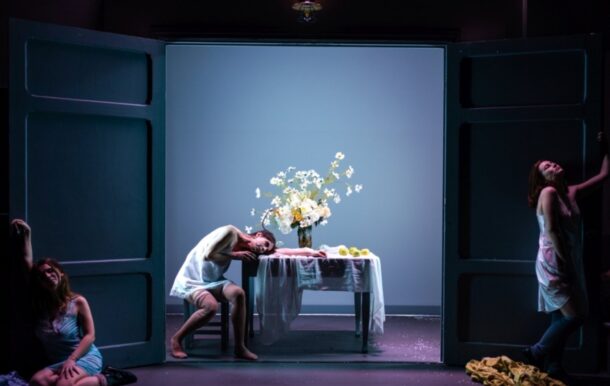
The Poor Girls’ Town, directed by Radu Afrim. Photo: Marin Sorescu National Theatre.
Once upon a time… it is not only fairy tales with beautiful princesses that happen in the time and space of a “once upon a time” that promises a happy ending. The sad stories of girls born to non-royalty also in a “once upon a time” begin their drama. And the ending is not always happy. Happiness, as much as it might be in a bildungsroman that leaves scars on the soul, cannot be anything but resigned. Beauty, however, is not just a thin shell with fine skin, dashing eyes and soft hair. The authentic beauty, which does not stand in the stalls of those who sell illusions and lies, the beauty known only by those who turn their eyes away from bright and noisy advertisements, the strange and sad beauty of a destiny calligraphed by a rough hand, with a rusty nib steeped in an inkwell filled with torment, that is the beauty for which it is worth travelling overseas and to far-away countries to liberate it from the tower guarded by dragons.
The Poor Girls’ Town, written and directed by Afrim based on Radu Tudoran’s short stories, staged at the Mihai Eminescu National Theatre in Iaşi, contains this priceless kind of beauty. The sad story of a city that seems to be torn from the map, in a frozen Bessarabian steppe and confined in a reality suspended by time and space, is told by its poor and beautiful girls with their bodies of both damnation and blessing. When freezing is synonymous with poverty, and poverty translates into an all-powerful frost over spirit and matter, this double-edged sword spins the destinies it divides into half-hopes of survival. And then the body that is subdued under the blows of this deadly weapon becomes the only currency that can buy an extra day in this frozen world.
The poem-show in which ten female entities exist and exude emotion through presence is yet another kinetic painting that Afrim puts in the frame of his spectacular universe—so fascinatingly and authentic. Womanhood is suggested through the gestures, glances, and stories spoken in a rhythm of a litany by these feminine creatures who live their humble lives between sins, fear, hunger, misery and a glimmer of humanity and solidarity. It is a solid womanhood: without any of the commercial “make-up” we are used to nowadays. It has nothing to do with the tenderness, fragility, coquetry, or sex appeal that we automatically associate with this concept. The femininity that Afrim celebrates in this show is stronger than any anthem or manifesto. Your emotions are stirred. The message is more pertinent, and it hurts more because the aesthetic form is so elaborate; the beautiful metaphor enhances the meanings of each word up to a point of pure emotion.
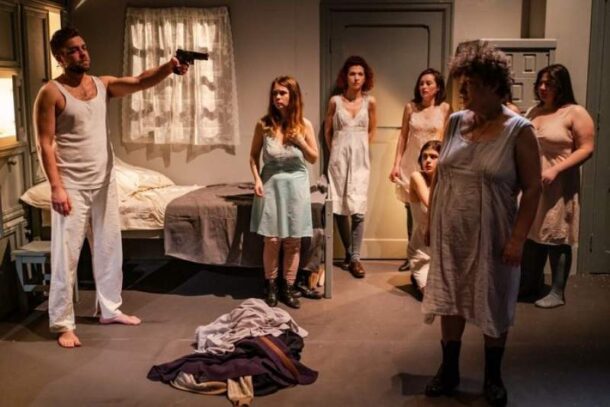
The Poor Girls’ Town, directed by Radu Afrim. Photo: Marin Sorescu National Theatre.
In a small, glacial room, where an old stove is constantly fed with logs, nine girls gather around the only male figure – Marinică. He is the man of their dreams only because he is the only one they know and the only one who can provide a warm, safe space for their poverty and fears. They all become his lovers and they all enter the small room with the old stove. They are not prostitutes by will, but by chance—an unfortunate fate predicted for them by being born in this God-forsaken village. In a monologue vivid and full of humor, Marusia, the chubby and funny fisherman’s daughter, explains how lucky she is to sell her father’s catch and smell like the salted, smoked variety of fish – nobody approaches her this way and she is safe. Mura, the main character, the most beautiful and fierce girl in the village, passes through Marinică’s bed as well. Later she faces the lust and anger of an officer and finally finds a decent and innocent stranger whom she tricks into remaining in the village. Like a mermaid, she attracts him with her charms and makes him her protector and husband.
As in a lucid dream, you are carried from one story to another, from storyteller to storyteller, until you transform yourself from the objective observer seated in the hall into a witness in defence of these lost souls in their rollercoaster ride of needs and sufferings. The process of this intimate storytelling, in which the monologues urge you to become an active receiver, empower concentration and, at the same time, create a fluent rhythm. The atmosphere is the main character in the show, in intimate relation with the group of women. In a Rembrandt-like shady light, the atmosphere of this world that seems to come from a long time ago and from far away seems to advance over the spectator step by step, patiently, until you feel yourself as a poor girl in that forgotten town. Throughout the waves of mist coming out of the symbolic stove of brief warm happiness, Afrim conceived sonority as a continuum of mourning like a dense fluid in which the ancestral sonorities float, like palpable energies that accompany broken destinies.
In this performance from Iaşi, the poor girls embody nostalgia and love and loneliness and they are the ones around whom the space seems to be taking shape. Cosmin Florea conceived the scenography by dividing the stage into separate spaces often used in simultaneous scenes. The bed becomes the cross on which girls repeatedly crucify their souls to save their bodies. Just as the girls themselves seem to be multiplications of the same destiny—a collective character from which a personal sadness is individually unleashed. The décor replicates the same pattern in many small objects: paintings of different shapes and sizes of the same image, many doors of empty cabinets that open to nowhere, lanterns in bundles and two symbolic shop windows on the right and left, in which cold and frost are kept as knick-knacks of pride–the boundaries in which those condemned to life postpone their death.
The most touching images remain the group scenes; songs sung in canon or babbled in a wail scattered throughout the stage or cramped into a single soul with ten bodies sheltered by the frame of a door. Diana Roman composed these vocal sounds that seem to come from afar, from a continuous time we recognize as part of us all. Death and life seem to have changed their roles into a wager for the immortal souls of these women. The one who perishes from illness is the only one who escapes from the trap of fate. Even the wave of hope in the finale, the end in which the possible rescue of the protagonist is glimpsed, is actually nothing more than an extension of the same captive existence in the universe of cold and hunger. An unknown man from nowhere who seems to be the hero on the white horse of happiness does not take Mura, the protagonist, on horseback in the dusky light, he himself remains trapped in the phantom-like town. He also becomes part of the frozen picture. And Mura, who sold herself for a coat and lost herself for a perfume, left without anything in return, with her trace lost somewhere in the reeds. She sees in this stranger the chance to become herself a stranger to this outer world, outside the barrier of frost.
The acting highlights of The Poor Girls’ Town consist of fine-tuning everyone to the same inner rhythm. Monologues seem to be uttered by the same will with different bodies and other voices. The intensity of Ada Lupu’s interpretation, the authenticity, and sincerity in the twinkling eyes of Mălina Lazar’s thoughts, the savor of Diana Vieru’s bitterly-tonic cheerfulness and the heartbreaking lucidity of Puşa Darie are the landmarks that mourn the course of this broken soul of the city divided in them all. You remember the faces and the sonorities of the voices, but mostly the eyes. Many pairs of sad eyes that dry up their stream of tears in a frozen glimmer. You feel how the performance looks you straight in the eye and claims not only your attention, but the courage to recognize the cold harsh truth.
The Poor Girls’ Town has a scent of frost and smoke of the nostalgic cities of which today only piles of ruins remain. This space-time from a steppe can also be found in slums, old streets, dead ends, and ghettos. We know them and we still find them in provincial towns where the 21th century has not rushed to replace everything with glass and aluminum, yet. Frost and smoke smell like poverty and unhappiness. And this performance manages to visually embody this persistent whiff in our cultural consciousness.
“dog with man. dog without a man.” man with a soul. man without lies
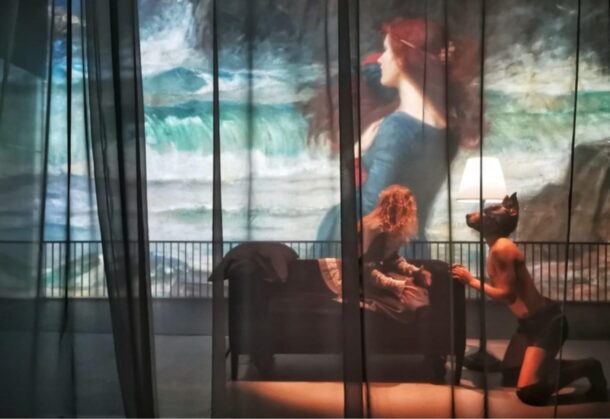
dog with man. dog without a man, directed by Radu Afrim. Photo: Marin Sorescu National Theatre.
We are bundles of dreams, ambitions, anxieties, and weaknesses. No matter how perfect we want our lives to seem, no matter how impeccable our conduct is, and no matter what professional performances we are capable of, when we remove the skins that show us as beautiful, we are left with the ball from which the threads of these four aspects of sincerity are intertwined in a warm jersey of feelings. When we are no longer “always busy” with appearances and allow ourselves to feel; our dreams, possibilities, anxieties, and sensibilities are unravelled from the nooks and crannies where we hide. There is nothing more beautiful than to allow yourself to get excited, to laugh loudly and healthily, or to roar at an affliction that does not find its remedy in an expensive prescription signed by an eminent doctor. Caring, pity, friendship, love, despair, the need to be together, loneliness, fears, fondness, generosity, horror, all this madness of emotions–dreams, little ambitions, anxieties, and weakness; these are the feelings that float throughout every scene. In the midst of it, we are the ones who we have forgotten to be.
The performance dog with man. dog without a man directed by Afrim at the Marin Sorescu National Theatre in Craiova, makes you think about these corners of humanity that we avoid displaying—these soul fragments that we are afraid of, lest they show us too vulnerable. The seventeen-episode suite, divided into two parts, over the course of four hours separated by a prolonged break, can intimidate by duration. How long can one listen to stories about dogs? A long time and with growing interest, because the duration of the personal universe poured out of Afrim’s sensitivity and dreams cancels the “perfection” of standard clocks. You perceive the duration differently in this fluid space-time, in which the characters come, tell their story and leave.
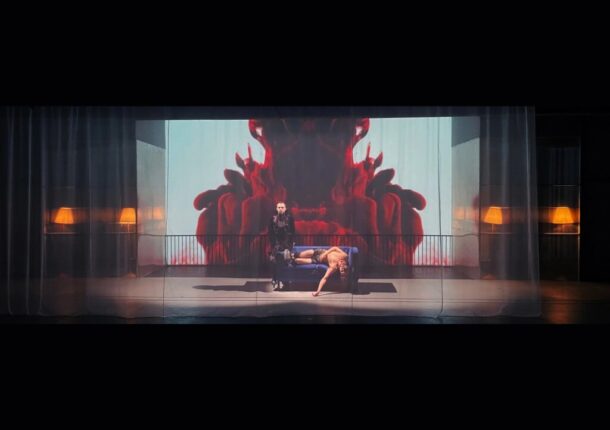
dog with man. dog without a man, directed by Radu Afrim. Photo: Marin Sorescu National Theatre.
With a suggestive scenography made up of several supporting elements and costumes containing the dominant feature of the harmonized characters balanced by Irina Moscu, a symbol-infused choreography of Flavia Giurgiu tuned to the rhythm of each episode and a projection made up of the video effects and animation designed by Cristian Niculescu that precisely denote the contexts, the frames of these cores of sincerity seem to be simple solutions, with maximum effect. The calculated slowness of some scenes or—on the contrary—the dynamism of others, are completed by the strange sonic universe, full of counterpoints, sprinkled with humor, dense, and solemnly made up of the same stuff as Afrim’s dreams.
With this fascinating relationship between dog and man at its core, the stakes of the show are centered on a higher-ranking emotion. Choosing as the main theme these beings whose soul does not cease to amaze us by the continuous evidence of loyalty, love, companionship, patience, and even humanity seems to be a guarantee for success. The show, however, does not stick to these well-known stereotypes; it is not an amalgamation of sweetness and ahs and ohs sighing in the face of four-legged wonders. The sensitivity of the spectator is put to the test in seventeen different ways—from pity and horror and shock to lyricism, intellectual emotion and uninhibited laughter. Each time with balance, details, nuances, counterpoints, well-motivated rhythm and a functional aesthetic. Drawn on paper, the graph of the show is a willful sinusoidal—with a few peaks and a few dips between them: a time not only for make-up and costume changes but also a break for the perceptive power of the audience—you have time to rest your soul and mind to be able to receive another story. Excessive lengths are inevitable in such a marathon and exist in several of the episodes, especially in the second part. Some scenes may wear out the spectator’s concentration and exhaust one’s attention. But just when you think there is no room for anything else, the final scenes surprise you with ferocity. There are the real-life video inserts: footage shot in a Romanian village, where an old lady patiently talks about the misery of stray dogs that she feeds and takes care of and an old, sick dog’s excruciating climb down four flights. Between these two very emotionally impactful episodes, “The Dogcatcher” represents the climax of the performance – a story written by Radu Tudoran, adapted by Radu Afrim for the stage about a brutal human being who catches ill dogs for a living only to become one himself. The chorus is a multicharacter who forces his metamorphoses and his aching physicality to create a choreography that marks, with strong touches, a powerful and hard-to-forget scene. This final triptych explains—not at all didactically—the entire artistic approach.
These human hypostases viewed from a canine perspective are possible only because of the refined performance of the entire cast. In addition to the technical and fluid synchronization, the actors rely on listening with meaning and well-articulated personal expressiveness. dog with man. dog without a man is a show that amplifies all your feelings in hidden places, which you rarely bring to light. After this encounter with a canine protagonist multiplied in many mirrors of his humanity, you feel less human—you, with all the merits, the manners, your intelligent procedures and the gadgets that come out of your pockets. And when you wash your shame from your hands and face, you bite your heart with your teeth and you cleave onto it until at least some of the layers of synthetic skin that you have diligently glued over your feelings are torn apart. And you are no longer so afraid of your dreams, ambitions, anxieties, and weaknesses.
Alina Epîngeac is a Romanian theatre critic. She graduated from the department of theatre studies at UNATC “I.L. Caragiale” of Bucharest and holds a Ph.D. in performing arts from UNATC “I.L. Caragiale” of Bucharest. She is one of the young critics who has emerged as a strong voice in the profession in the past years. At present, she is a lecturer at the National University of Theatre and Cinematographic Art “I.L. Caragiale” of Bucharest teaching cultural journalism and training younger future critics.

European Stages, vol. 17, no. 1 (Fall 2022)
Editorial Board:
Marvin Carlson, Senior Editor, Founder
Krystyna Illakowicz, Co-Editor
Dominika Laster, Co-Editor
Kalina Stefanova, Co-Editor
Editorial Staff:
Asya Gorovits, Assistant Managing Editor
Zhixuan Zhu, Assistant Managing Editor
Advisory Board:
Joshua Abrams
Christopher Balme
Maria Delgado
Allen Kuharsky
Bryce Lease
Jennifer Parker-Starbuck
Magda Romańska
Laurence Senelick
Daniele Vianello
Phyllis Zatlin
Table of Contents:
- AVIGNON 76. A Festival of New Works by Philippa Wehle
- Almodóvar’s Women on the Verge in Portugal by Duncan Wheeler
- BRACK IMPERie. About “Hedda Gabler” by Vinge/Müller at Norske Teatret Oslo by Thomas Oberender
- Embodied Intimacy: The Immersive Performance of The Smile Off Your Face at Edinburgh by Julia Storch
- Fear, Love, and Despair – Radu Afrim: Director of Core Feelings by Alina Epîngeac
- Grec Festival de Barcelona, July 22 by Anton Pujol
- I Think of Curatorial Work in Scholarly Terms: An Interview with Ivan Medenica by Ognjen Obradović
- New Worlds Revealed in an Immigrant Journey, and an Unexpectedly Meaningful Universe Discovered and Destroyed Inside Styrofoam, at the Edinburgh Festival by Mark Dean
- Participation, Documentary and Adaptation: Barcelona Theatre May 2022 by Maria Delgado
- Report from Berlin, April 2022 by Marvin Carlson
- Report from Berlin (and Hamburg….) 5/2022 by Philip Wiles
- The Sibiu International Theatre Festival Transforms Dreams into Reality (The Magic of 2022 FITS in Short Superlative) by Ionica Pascanu
- Theatre in Denmark and The Faroe Islands – Spring 2022 by Steve Earnest
- The Polish Nation in a Never-Landing Aircraft by Katarzyna Biela
- The Piatra-Neamt Theatre Festival in Romania: 146 Kilometers from Heart to Heart by Cristina Modreanu
- Will’s Way at the Shakespeare International Festival Craiova 2022 by Alina Epîngeac
- Interview with the Turkish theatre critic Handan Salta on TheatreIST by Verity Healey
www.EuropeanStages.org
europeanstages@gc.cuny.edu
Martin E. Segal Theatre Center:
Frank Hentschker, Executive Director
Marvin Carlson, Director of Publications
©2022 by Martin E. Segal Theatre Center
The Graduate Center CUNY Graduate Center
365 Fifth Avenue
New York NY 10016
European Stages is a publication of the Martin E. Segal Theatre Center ©2022


